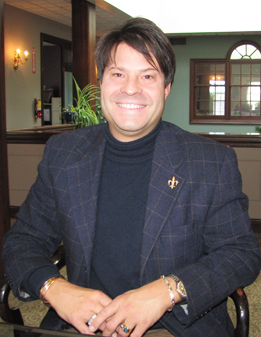|
“Homeownership is the
number-one method of accumulating wealth,” said John Taylor,
president and CEO of National Community Reinvestment
Coalition, a consumer advocacy group. In the United States,
“wealth and financial stability are inextricably linked to
housing opportunity and homeownership,” said Lisa Rice,
president of the National Fair Housing Alliance, an advocacy
group. Rice is the former president of the Toledo Fair
Housing Center and her thoughts are echoed by her successor
here in Toledo and the current president, Michael Marsh.
In the past, Marsh notes,
housing discrimination “increased the wealth of whites at
the expense of African Americans and created opportunities
for them that excluded African Americans, those
opportunities are tied to zip codes.”
That past included the
practice of redlining – a practice that the Center for
Investigative Reporting said in February of this year
persists in metro areas – extensively in 61 such areas –
even when taking into account the applicants’ income, loan
amount and neighborhood.
The practice of redlining
began in the 1930s when government surveyors graded
neighborhoods in 239 cities and color-coded them from green
(“best), to blue (“still desirable”) to yellow (“definitely
declining”) to red (“hazardous”). The redlining of certain
neighborhoods was due to the residents’ racial and ethnic
demographics – African American neighborhoods most
certainly, but also, in the 1930s, Catholic and Jewish
neighborhoods and those comprised of immigrants from Asia
and southern and eastern Europe. After World War II, Jews,
Irish Catholics, Italians and the rest of the previously
undesirable white immigrants started to become upwardly
mobile as the end of the Depression and the post war boom
leveled the playing field for Caucasians in general. Black
Americans remained in the red-lined neighborhoods since they
did not have the option to flee to the suburbs or to nicer
city neighborhoods.
|
|
“Zip codes can be more
important than genetic codes in predicting our outcomes,”
says Marsh.
Government-sanctioned
redlining continued through the 1950s and 1960s. As other
notable pieces of his domestic social legislation were
passed in the 1960s, such as the Civil Rights Act of 1964
and the Voting Rights Act of 1965, President Lyndon Johnson
found himself stymied on the issue of providing equal
opportunities in attaining homeownership. It wasn’t until
the assassination of Martin Luther King, Jr, on April 4,
1968 and the ensuing civil disturbances that LBJ was able to
piece together the votes in Congress to enact the Fair
Housing law he wanted. The bill was signed on April 11. The
law would forbid discrimination. The mission statement would
read, in part, “to build inclusive and sustainable
communities free from discrimination.”
|

Michael Marsh |
|
Fifty years after the
enactment of the law, a new secretary of HUD, Ben Carson,
would amend the mission statement and omit the word
“discrimination.” Given the act’s ineffectiveness over five
decades and the decision to pretend that discrimination in
housing doesn’t exist, the 50-year celebration seems
bittersweet. The new mission statement reads: “to ensure
Americans have access to fair, affordable housing and
opportunities to achieve self-sufficiency.” The new
statement ignores the fact that discrimination has existed
and still exists.
Whether racial
discrimination exists or not, the fact is that the
homeownership gap, according to the Center for Investigative
Reporting, had been shrinking since the 1970s but has
increased dramatically since the housing bust and is now
wider than it has been since the Jim Crow era.
According to the report,
the most disturbing “pattern of troubling denials for people
of color across the country,” exists in 61 major
metropolitan areas such as Atlanta, Detroit, Philadelphia,
St. Louis and San Antonio. The analysis shows that black
applicants were denied access to loans at much higher rates
than whites in 48 cities, Latinos in 25 cities, Asians in
nine and Native Americans in three. In Washington, D.C,
ironically enough, all four groups were denied at a
significantly higher rate.
Toledo is not on the list
of the 61 most troubled cities.
If government and elected
officials have been reluctant over the past 50 years to
enforce the Fair Housing Act, and they certainly have been
starting with the obstructionism of the government under
President Richard Nixon, LBJ’s immediate successor, (“the
United States government has been a major impediment to
meeting the goals of the Fair Housing Act,” says Marsh),
non-profit agencies have helped to continue the struggle
even if they have not had the clout to fully eliminate the
homeownership gap or discrimination. Perhaps there is no
better example of this activism than in Toledo.
Shanna Smith headed the
local Fair Housing Center for 15 years and during that time
she gained a reputation for her fearlessness in trying to
uphold the tenets of the Fair Housing Act and ending
discrimination in housing and eliminating segregated living
patterns.
|
Her aggressiveness led to a federal court decision
in the landmark case, Shellhammer vs. Lewallen, in
which Smith and her team investigated a tenant’s
complaint against a landlord of sexual harassment
and argued, with attorney C. Thomas McCarter, that
such harassment should be covered in the FHA.
Eventually, after moving up the hierarchy of federal
courts which had initially denied that sexual
harassment was included in the Fair Housing Act,
Smith and McCarter prevailed and over 70 victims
were granted relief – most of them black and poor. |

Shanna Smith |
Smith would leave Toledo
26 years ago to found the National Fair Housing Alliance and
Lisa Rice would succeed her in Toledo until being called
herself to join Smith at the NFHA. Smith retired as CEO in
the last several weeks and Rice has been named CEO.
Following this stellar line up of local presidents is
Michael Marsh who has led the agency for the past five
years. During his time at FHC – he first joined the agency
in 1996 as a volunteer and was hired a year later – he has
led the agency to take on the big insurance companies and
has seen a “change in the way homeowners insurance has been
underwritten,” he says. The agency has reached a $3.3
million settlement with KeyBank to correct their lending
patterns and has reached a settlement with Wells Fargo when
“we found them doing a poor job of maintaining and marketing
homes in poor neighborhoods after doing a great job in white
neighborhoods [after the housing bust]” says Marsh.
The $1.4 million Wells
Fargo settlement has created funding for the Lucas County
Land Bank’s roof replacement program, chair lifts for the
disabled, and a foreclosure prevention program.
Such successes are not
easily attained. Funding is an ongoing issue for the
non-profit agency. Public funding has decreased, causing the
agency to drop its staff from a high of 16 to its current 10
members. Raising private funds, says March, a certified
fundraiser himself, is difficult for such an abstract,
policy cause.
The demographics of
discrimination have shifted, says Marsh. “Disability has
replaced race as the largest number of complaints as baby
boomers age,” he says. The agency is preparing to file a
case in federal court involving disability discrimination
and is involved in a good deal of education and outreach on
the subject.
And testing, of course.
Shanna Smith demonstrated 45 years ago the effectiveness of
testing – getting out into the community, taking a proactive
approach in talking to people and uncovering examples of
discrimination is an important follow-up to the calls and
inquiries the agency receives. “We do testing to ferret out
complaints,” says Marsh. “We are the only group that does
testing.” |